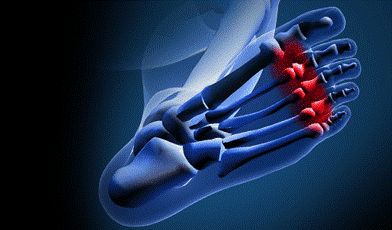Metatarsalgia is defined as a painful foot condition in the metatarsal region of the foot that affects the bones and joints located at the ball-of-the-foot. Metatarsalgia is most often located under the 2nd, 3rd, and 4th metatarsal heads. Metatarsalgia occurs when the metatarsal arch becomes flattened causing one or more of the metatarsal heads to become painful and/or inflamed, usually due to excessive pressure over a long period of time. As we get older, the fat pad in our foot tends to thin out, making us much more susceptible to pain in the ball-of-the-foot. Some of the factors that can contribute to excessive localized pressure over the forefoot are:
- High impact activities without proper footwear and/or orthotics

- Prominent metatarsal heads
- Tight toe extensors (muscles)
- Weak toe flexors (muscles)
- Hammer toe deformity
- Hypermobile first foot bone
- Tight Achilles tendon
- Excessive pronation (side-to-side movement of the foot when walking or running)
- Ill-fitting footwear (shoes with heels that are too high or shoes that are too narrow)
Anatomical conditions that may predispose individuals to forefoot problems include:
- A high arch
- A short first metatarsal bone or a long second metatarsal bone is often seen in people with Morton's toe. This causes a disturbance in the normal forefoot balance by shifting an abnormal amount of weight onto the second metatarsal.
- Hammer toe deformity
The key components to treating metatarsalgia are to identify the cause of the pain starting with shoe fit and function as well as an orthotic intervention to control foot mechanics and reduce stress patterns. Sole Remedy can help! Call today for an appointment.
Sole Remedy specializes in gait analysis, foot type assessment, musculoskeletal injury management, and fall prevention.
Phone: 508-295-8800 or 855-FOOT RX 9 to schedule an appointment today!
